October 2024
The global commercial greenhouse market size accounted for USD 38.22 billion in 2024, grew to USD 41.82 billion in 2025 and is predicted to surpass around USD 93.87 billion by 2034, representing a healthy CAGR of 9.40% between 2024 and 2034. The North America commercial greenhouse market size is calculated at USD 12.61 billion in 2024 and is expected to grow at a fastest CAGR of 9.55% during the forecast year.
The global commercial greenhouse market size is estimated at USD 38.22 billion in 2024 and is anticipated to reach around USD 93.87 billion by 2034, expanding at a CAGR of 9.40% from 2024 to 2034.
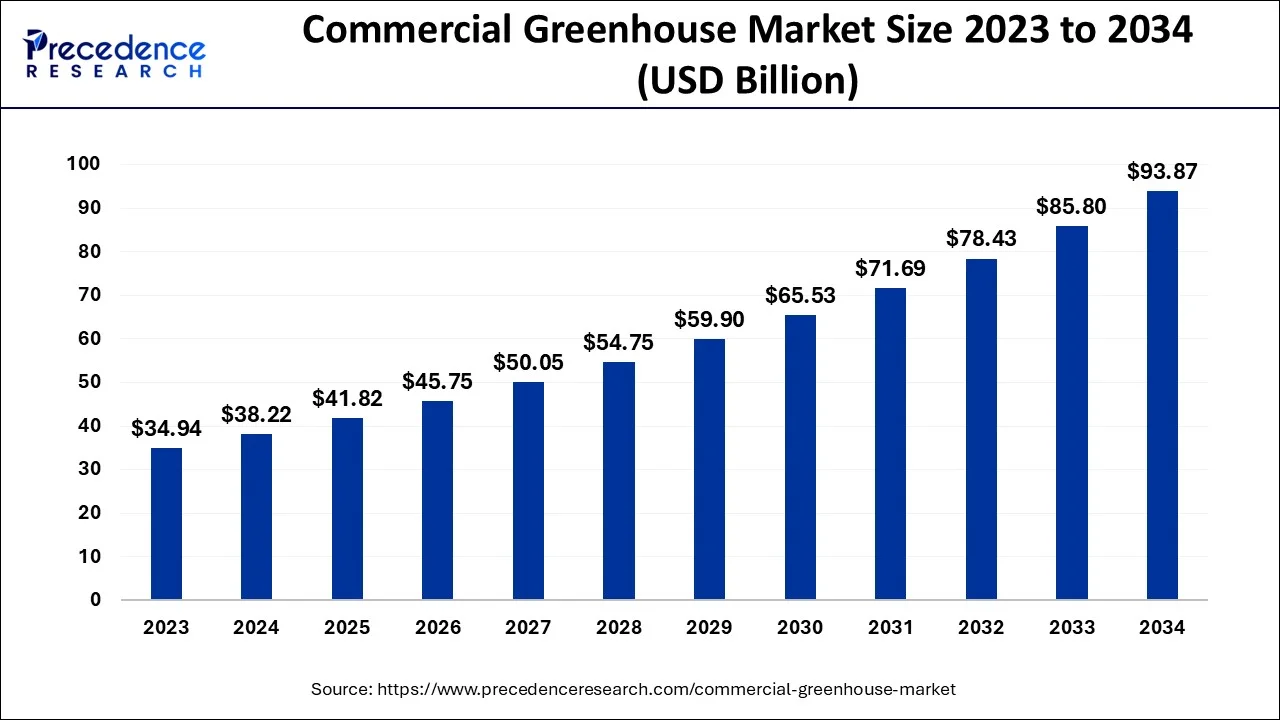
The U.S. commercial greenhouse market size is evaluated at USD 8.83 billion in 2024 and is predicted to be worth around USD 22.17 billion by 2034, rising at a CAGR of 9.62% from 2024 to 2034.
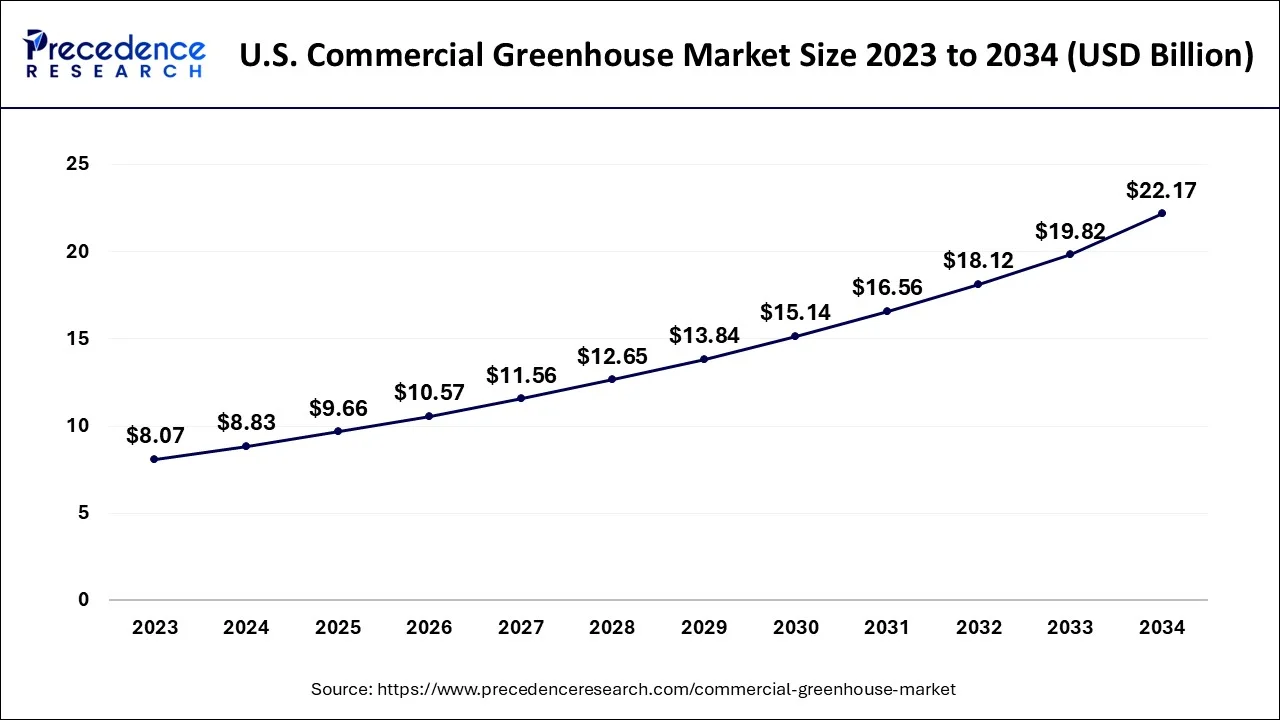
Significant market shares are held by Europe and North America, while Asia-Pacific is seeing the quickest growth. As a result of extensive greenhouse farming in nations like Italy, Spain, and the Netherlands, Europe was the first to use cutting-edge technology in greenhouses. Due to its fast urbanization, quick technical improvements, and strong demand for fruits and vegetables, Europe is the greatest participant. Over the course of the projection period, the commercial greenhouse market in the Asia-Pacific region is anticipated to develop at a high rate due to the area's rapidly expanding population and shrinking arable land, notably in China and India.
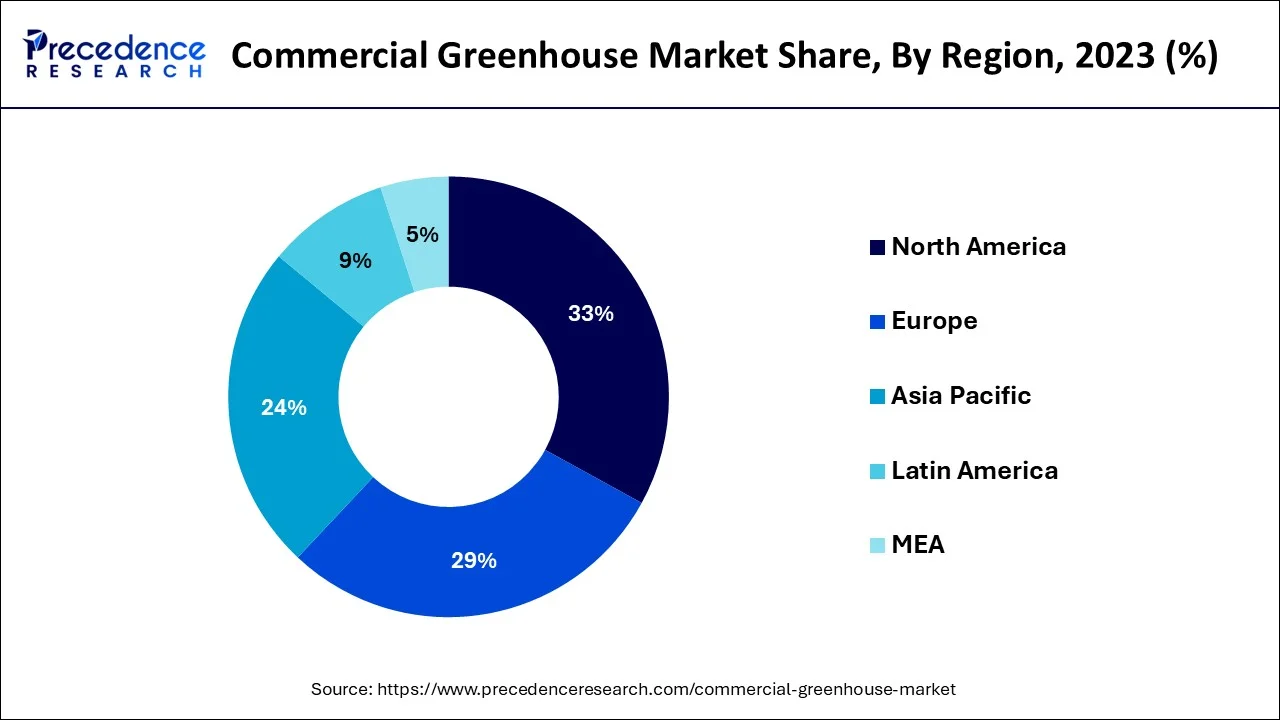
Consumers can grow flowers, fruits, vegetables, and transplants for planting in commercial greenhouses, which provide highly controlled and stable environments. Because of this, greenhouse plants can reliably produce despite regional temperature, soil, or terrain restrictions. In commercial greenhouses, plants are often produced in large quantities for consumers. Farmers have more control over the environment in which their crops grow because to greenhouse farming.
The commercial greenhouse market is expanding mostly due to rapid urbanization and a lack of available arable land. Additionally, the development of commercial greenhouses is a result of the shifting weather patterns that affect conventional farming. More control over the environment in which crops grow is provided through the use of greenhouse farming. A good yield is possible for farmers if they can effectively control the temperature, the irrigation system, the air humidity, and the light. Farmers can estimate how much they will harvest and keep their crops healthier by having that much control over their growth. Farmers are able to grow flowers, vegetables, and fruit crops all year round thanks to their capacity to manage the environment.
Crop genetics can be enhanced by growing them in the controlled atmosphere of a greenhouse, encouraging the development of wholesome cultivars. In addition, less water is required than in an open field. Producers may use all the herbicides and pesticides they need to prevent illnesses and any other plant vulnerabilities because they are not dependent on bees for pollination. In an open field, insects, animals, and locusts may pose a threat to the produce's quality. Due to the controlled medium and environmental factors, crop cycles in greenhouse farming are also quicker than in traditional agriculture, with vine crop productivity more than twice as high. Additionally, compared to traditional agriculture, vertical farming has a land productivity that is more than twice as high and twice as quick. However, there are several obstacles that could limit market expansion, including the need for precise technology in a regulated growth environment and the expensive setup costs.
Rapid urbanization and a lack of arable land are driving the growth of the commercial greenhouse industry. The employment of commercial greenhouses in conventional farming has also been encouraged by changing weather patterns, and this trend will spur the market's expansion even further. Additionally, one of the main factors influencing the growth of commercial greenhouses is their ability to produce high yields in compared to conventional agricultural methods. Another important aspect is the expanding population, which will slow the market's growth pace and increase the need for food. Additionally, the market for commercial greenhouses would benefit from expanding floriculture and decorative horticulture applications as well as rising demand for fruits and vegetables in underdeveloped countries.
| Report Coverage | Details |
| Market Size in 2024 | USD 38.22 Billion |
| Market Size by 2034 | USD 93.87 Billion |
| Growth Rate from 2024 to 2034 | CAGR of 9.40% |
| Base Year | 2023 |
| Forecast Period | 2024 to 2034 |
| Segments Covered | Equipment, Crop Type, Type, Component, and Geography |
Higher yields are required while using less water and space
A small number of crops are suited for greenhouse farming
High Capital Expenditure - Crops grown in greenhouses require particular environmental conditions in order to grow properly. It is crucial to keep an eye on the ideal air quality, temperature, and relative humidity. They require the best possible light and water for growth. According to the requirements of each crop's growth stage, the nutrient levels available to the plants should be regularly monitored and gradually changed to the proper levels. Monitoring and precision of natural resources and fertilizers are essential for growing crops in greenhouses. This entails having a thorough awareness of the crop, the surrounding environment, and the plants' ideal requirements. As a result, these crops are frequently grown properly by expert farmers. The right setup and additional illumination of the irrigation systems are among the other factors. All of these are expensive and difficult for conventional farmers to perform, especially in developing nations.
Heating systems will have the greatest CAGR throughout the predicted timeframe. Heating systems are one of the most important requirements for the effective growth of plants in commercial greenhouses. Systems that keep the temperature steady and don't emit any hazardous substances help plants grow.
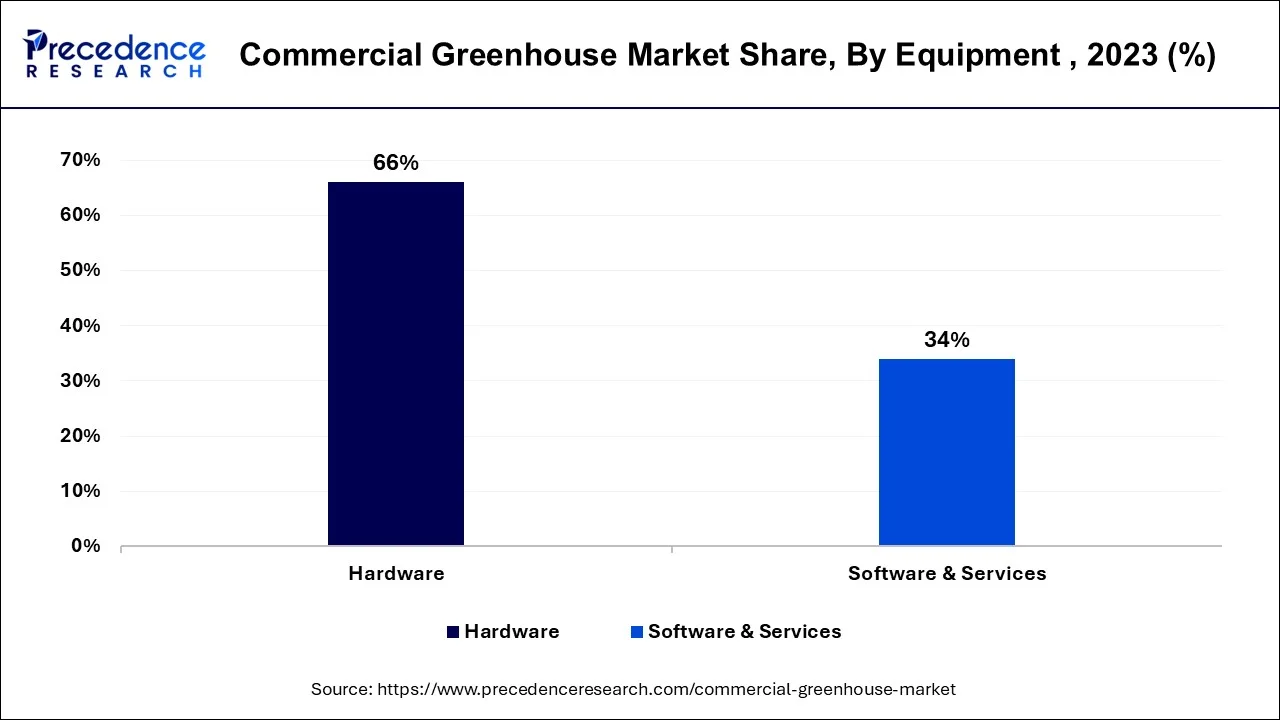
The best way to maintain the proper temperature is with a heating system. These systems may be administered centrally or decentralized. In colder months, greenhouses commonly use radiant hot water heating systems to keep their interiors warm. Because flow control enables effective temperature adjustment, these heating systems use mixing valves to regulate the temperature of the heating pipes.
Vegetables are predicted to see the highest CAGR increase throughout the course of the projection period. Vegetables do well in greenhouse environments. Without having to worry about the climate, temperature, or other environmental changes, vegetables may be cultivated all year round. Vegetables produced in greenhouses are protected from bad weather, such as cold, wind, pests, drought, searing heat, and animals that would want to eat them. Growing vegetables there also permits the establishment of the optimal circumstances for the crops due to the regulating factors present in greenhouses, such as humidity, light, temperature, fertilizer, moisture, and irrigation.
The market for plastic greenhouses is predicted to grow more swiftly than that for glass greenhouses. To make commercial greenhouse plastic more durable than traditional plastic, a distinct manufacturing process is used. The unique design of this material makes it resistant to tearing and extreme weather conditions.
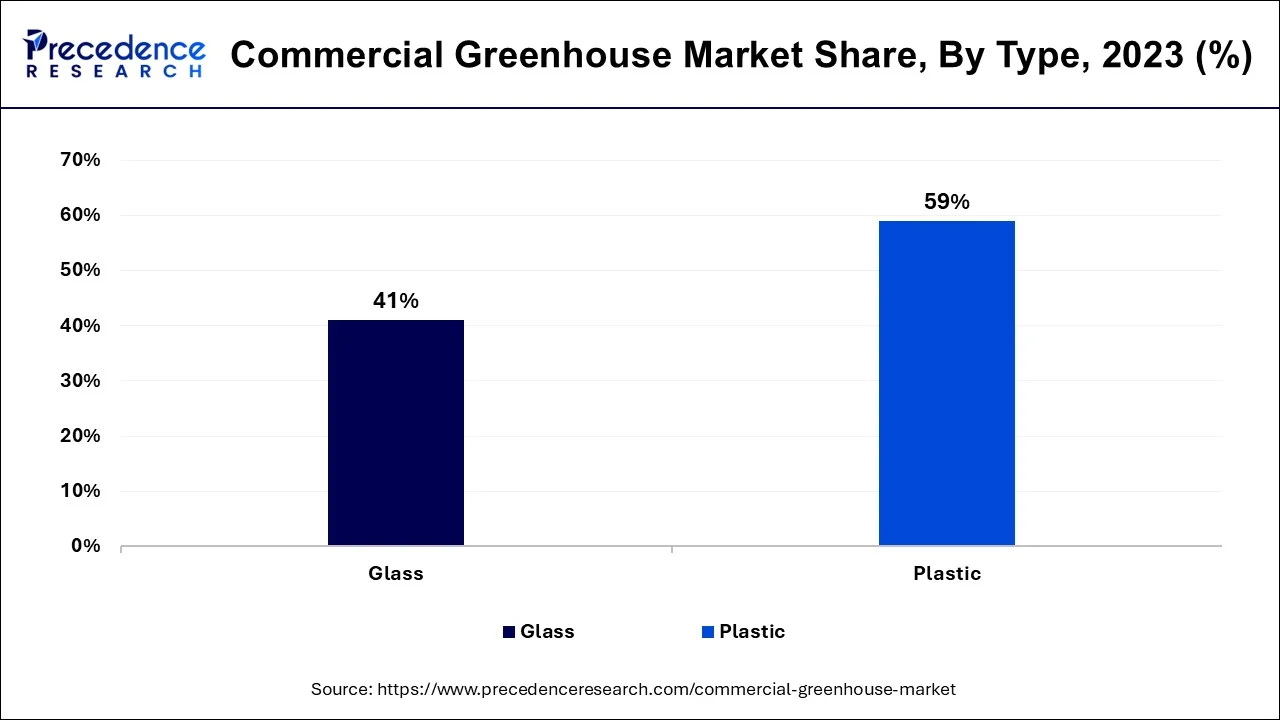
By Equipment
By Crop Type
By Type
By Component
By Geography
For inquiries regarding discounts, bulk purchases, or customization requests, please contact us at sales@precedenceresearch.com
No cookie-cutter, only authentic analysis – take the 1st step to become a Precedence Research client
October 2024